A Parameterization Approach for the Dielectric Response Model of Oil Paper Insulation Using FDS Measurements
Abstract
:1. Introduction
2. Equivalent Model of OIP Insulation
3. Methodology of Model Parameterization
3.1. Problem Statement
3.2. Algorithm
3.3. Akaike Information Criterion (AIC)
4. Case Study
4.1. Dielectric Response Measurement
4.2. Parameter Identification Results
4.3. Polarization Current Modelled from FDS
4.4. RVM Modelled from FDS
5. Conclusions
Author Contributions
Conflicts of Interest
References
- Lee, B.; Park, J.W.; Crossley, P.A.; Kang, Y.C. Induced Voltages Ratio-based Algorithm for Fault Detection and Faulted Phase and Winding Identification of a Three-winding Power Transformer. Energies 2014, 7, 6031–6049. [Google Scholar] [CrossRef]
- Wang, C.; Wu, J.; Wang, J.; Zhao, W. Reliability Analysis and Overload Capability Assessment of Oil-immersed Power Transformers. Energies 2016, 9, 43. [Google Scholar] [CrossRef]
- Godina, R.; Rodrigues, E.M.G.; Matias, J.C.O.; Catalão, J.P.S. Effect of Loads and Other Key Factors on Oil-transformer Ageing: Sustainability Benefits and Challenges. Energies 2015, 8, 12147–12186. [Google Scholar] [CrossRef]
- Martin, D.; Saha, T. A Review of the Techniques Used by Utilities to Measure the Water Content of Transformer Insulation Paper. IEEE Electr. Insul. Mag. 2017, 33, 8–16. [Google Scholar] [CrossRef]
- Fofana, I.; Hadjadj, Y. Electrical-Based Diagnostic Techniques for Assessing Insulation Condition in Aged Transformers. Energies 2016, 9, 679. [Google Scholar] [CrossRef]
- Gubanski, S.M.; Boss, P.; Csepes, G.; Der, H.V.; Filippini, J.; Guuinic, P.; Gäfvert, U.; Karius, V.; Lapworth, J.; Urbani, G. Dielectric Response Methods for Diagnostics of Power Transformers. IEEE Electr. Insul. Mag. 2003, 19, 12–18. [Google Scholar] [CrossRef]
- Koch, M.; Prevost, T. Analysis of Dielectric Response Measurements for Condition Assessment of Oil-Paper Transformer Insulation. IEEE Trans. Dielectr. Electr. Insul. 2012, 19, 1908–1915. [Google Scholar] [CrossRef]
- Setayeshmehr, A.; Fofana, I.; Eichler, C.; Akbari, A.; Borsi, H.; Gockenbach, E. Dielectric Spectroscopic Measurements on Transformer Oil-paper Insulation under Controlled Laboratory Conditions. IEEE Trans. Dielectr. Electr. Insul. 2008, 15, 1100–1111. [Google Scholar] [CrossRef]
- Tenbohlen, S.; Coenen, S.; Djamali, M.; Müller, A.; Samimi, M.H.; Siegel, M. Diagnostic Measurements for Power Transformers. Energies 2016, 9, 347. [Google Scholar] [CrossRef]
- Xia, G.; Wu, G.; Gao, B.; Yin, H.; Yang, F. A New Method for Evaluating Moisture Content and Aging Degree of Transformer Oil-Paper Insulation Based on Frequency Domain Spectroscopy. Energies 2017, 10, 1195. [Google Scholar] [CrossRef]
- Hadjadj, Y.; Meghnefi, F.; Fofana, I.; Ezzaidi, H. On the Feasibility of Using Poles Computed from Frequency Domain Spectroscopy to Assess Oil Impregnated Paper Insulation Conditions. Energies 2013, 6, 2204–2220. [Google Scholar] [CrossRef]
- Smith, D.J.; McMeekin, S.G.; Stewart, B.G.; Wallace, P.A. A Dielectric Frequency Response Model to Evaluate the Moisture Content within an Oil Impregnated Paper Condenser Bushing. IET Sci. Meas. Technol. 2013, 7, 223–231. [Google Scholar] [CrossRef]
- Raetzke, S.; Koch, M.; Anglhuber, M. Modern Insulation Condition Assessment for Instrument Transformers. In Proceedings of the 2012 IEEE International Conference on Condition Monitoring and Diagnosis, Bali, Indonesia, 23–27 September 2012. [Google Scholar]
- Koch, M.; Raetzke, S.; Krueger, M. Moisture Diagnostics of Power Transformers by a Fast and Reliable Dielectric Response Method. In Proceedings of the Conference Record of the 2010 IEEE International Symposium on Electrical Insulation, San Diego, CA, USA, 6–9 June 2010. [Google Scholar]
- Gao, J.; Yang, L.; Wang, Y.; Liu, X.; Lv, Y.; Zheng, H. Condition Diagnosis of Transformer Oil-paper Insulation Using Dielectric Response Fingerprint Characteristics. IEEE Trans. Dielectr. Electr. Insul. 2016, 23, 1207–1218. [Google Scholar] [CrossRef]
- Zhang, Y.; Liu, J.; Zheng, H.; Wei, H.; Liao, R. Study on Quantitative Correlations Between the Ageing Condition of Transformer Cellulose Insulation and the Large Time Constant Obtained from the Extended Debye Model. Energies 2017, 10, 1842. [Google Scholar] [CrossRef]
- Fofana, I.; Hemmatjou, H.; Meghnefi, F.; Farzaneh, M.; Setayeshmehr, A.; Borsi, H.; Gockenbach, E. On the Frequency Domain Dielectric Response of Oil-paper Insulation at Low Temperatures. IEEE Trans. Dielectr. Electr. Insul. 2010, 17, 799–807. [Google Scholar] [CrossRef]
- Gao, J.; Yang, L.; Wang, Y.; Qi, C.; Hao, J.; Liu, J. Quantitative Evaluation of Ageing Condition of Oil-paper Insulation Using Frequency Domain Characteristic Extracted from Modified Cole-Cole Model. IEEE Trans. Dielectr. Electr. Insul. 2015, 22, 2694–2702. [Google Scholar] [CrossRef]
- Saha, T.K.; Purkait, P.; Muller, F. Deriving an Equivalent Circuit of Transformers Insulation for Understanding the Dielectric Response Measurements. IEEE Trans. Power Deliv. 2005, 20, 149–157. [Google Scholar] [CrossRef]
- Verma, H.C.; Verma, H.C.; Baral, A.; Pradhan, A.K.; Chakravorti, S. Condition Assessment of Various Regions within Non-uniformly Aged Cellulosic Insulation of Power Transformer Using Modified Debye Model. IET Sci. Meas. Technol. 2017, 11, 939–947. [Google Scholar] [CrossRef]
- Baral, A.; Chakravorti, S. Condition Assessment of Cellulosic Part in Power Transformer Insulation Using Transfer Function Zero of Modified Debye Model. IEEE Trans. Dielectr. Electr. Insul. 2014, 21, 2028–2036. [Google Scholar] [CrossRef]
- Liao, R.; Liu, J.; Yang, L.; Gao, J.; Zhang, Y.; Lv, Y.; Zheng, H. Understanding and Analysis on Frequency Dielectric Parameter for Quantitative Diagnosis of Moisture Content in Paper-oil Insulation System. IET Electr. Power Appl. 2015, 9, 213–222. [Google Scholar] [CrossRef]
- Liao, R.; Liu, J.; Yang, L.; Wang, K.; Hao, J.; Ma, Z.; Gao, J.; Lv, Y. Quantitative Analysis of Insulation Condition of Oil-paper Insulation Based on Frequency Domain Spectroscopy. IEEE Trans. Dielectr. Electr. Insul. 2015, 22, 322–334. [Google Scholar] [CrossRef]
- Giselbrecht, D.; Leibfried, T. Modelling of Oil-Paper Insulation Layers in the Frequency Domain with Cole-Cole Functions. In Proceedings of the Conference Record of the 2006 IEEE International Symposium on Electrical Insulation, Toronto, ON, Canada, 11–14 June 2006. [Google Scholar]
- Zheng, J.; Jiang, X.; Cai, J. Parameter Identification for Equivalent Circuit of Transformer Oil-paper Insulation and Effect of Insulation Condition on Parameters. Electr. Power Autom. Equip. 2015, 35, 168–172. [Google Scholar] [CrossRef]
- Jiang, X.B.; Huang, Y.J.; Lai, X.S. Improved Ant Colony Algorithm and its Application in Parameter Identification for Dielectric Response Equivalent Circuit of Transformer. High Volt. Eng. 2011, 37, 1982–1988. [Google Scholar] [CrossRef]
- He, D.; Cai, J. Method for Parameter Identification of Equivalent Circuit of Oil-paper Insulation and Its Research. High Volt. Eng. 2017, 43, 1988–1994. [Google Scholar] [CrossRef]
- Liu, J. Investigation of Time-Frequency Hybrid Insulation Diagnosis Method Based on PDC Analysis. Ph.D. Thesis, Harbin University of Science and Technology, Harbin, China, 2014. [Google Scholar]
- Sarkar, S.; Sharma, T.; Baral, A.; Chatterjee, B.; Dey, D.; Chakravorti, S. An Expert System Approach for Transformer Insulation Diagnosis Combining Conventional Diagnostic Tests and PDC, RVM Data. IEEE Trans. Dielectr. Electr. Insul. 2014, 21, 882–891. [Google Scholar] [CrossRef]
- Kumar, A.; Mahajan, S.M. Correlation between Time and Frequency Domain Measurements for the Insulation Diagnosis of Current Transformers. In Proceedings of the North American Power Symposium, Arlington, TX, USA, 26–28 September 2010. [Google Scholar]
- Kumar, A.; Mahajan, S.M. Time Domain Spectroscopy Measurements for the Insulation Diagnosis of a Current Transformer. IEEE Trans. Dielectr. Electr. Insul. 2011, 18, 1803–1811. [Google Scholar] [CrossRef]
- Xu, S.; Middleton, R.; Fetherston, F.; Pantalone, D. A Comparison of Return Voltage Measurement and Frequency Domain Spectroscopy Test on High Voltage Insulation. In Proceedings of the 7th International Conference on Properties and Applications of Dielectric Materials, Nagoya, Japan, 1–5 June 2003. [Google Scholar]
- Liu, J.; Zhang, D.; Wei, X.; Karimi, H.R. Transformation Algorithm of Dielectric Response in Time-frequency Domain. Math. Probl. Eng. 2014. [Google Scholar] [CrossRef]
- Zhang, T.; Li, X.; Lv, H.; Tan, X. Parameter Identification and Calculation of Return Voltage Curve Based on FDS Data. IEEE Trans. Appl. Superconduct. 2014. [Google Scholar] [CrossRef]
- Jota, P.R.S.; Islam, S.M.; Jota, F.G. Modeling the Polarization Spectrum in Composite Oil/paper Insulation Systems. IEEE Trans. Dielectr. Electr. Insul. 1999, 6, 145–151. [Google Scholar] [CrossRef]
- Bozdogan, H. Model Selection and Akaike Information Criterion (AIC)—The General-Theory and its Analytical Extensions. Psychometrika 1987, 52, 345–370. [Google Scholar] [CrossRef]
- Bozdogan, H. Akaike’s Information Criterion and Recent Developments in Information Complexity. J. Math. Psychol. 2000, 44, 62–91. [Google Scholar] [CrossRef] [PubMed]
- Symonds, M.R.E.; Moussalli, A. A Brief Guide to Model Selection, Multimodel Inference and Model Averaging in Behavioural Ecology Using Akaike’s Information Criterion. Behav. Ecol. Sociobiol. 2011, 65, 13–21. [Google Scholar] [CrossRef]
- Pourrahimi, A.M.; Olsson, R.T.; Hedenqvist, M.S. The Role of Interfaces in Polyethylene/metal-oxide Nanocomposites for Ultrahigh-voltage Insulating Materials. Adv. Mater. 2018. [Google Scholar] [CrossRef] [PubMed]
- IEEE. Standard General Requirements and Test Procedure for Power Apparatus Bushings; IEEE Std C57.19.00-2004 (Revision of IEEE Std C57.19.00-1991); IEEE: Piscataway Township, NJ, USA, 2005; pp. 1–17. [Google Scholar]
- Pradhan, A.K.; Chatterjee, B.; Chakravorti, S. Estimation of Dielectric Dissipation Factor of Cellulosic Parts in Oil-paper Insulation by Frequency Domain Spectroscopy. IEEE Trans. Dielectr. Electr. Insul. 2016, 23, 2720–2729. [Google Scholar] [CrossRef]
- Jonscher, A.K. Dielectric Relaxation in Solids; Chelsea Dielectric Press: London, UK, 1983. [Google Scholar]
- Zhongnan, X. Study on Simulation and Experiment of Polarization and Depolarization Current for Oil-Paper Insulation Ageing. Master’s Thesis, Chongqing University, Chongqing, China, 2011. [Google Scholar]
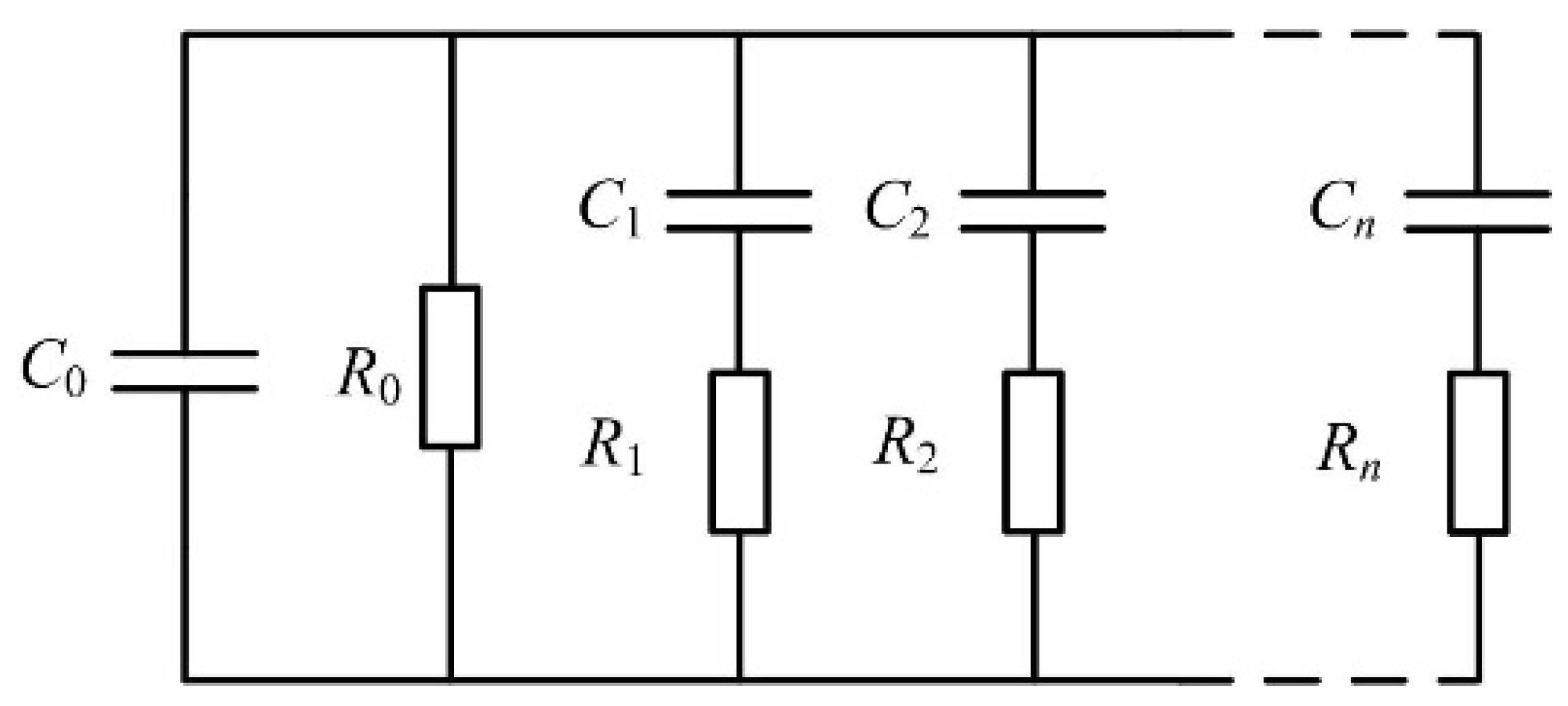
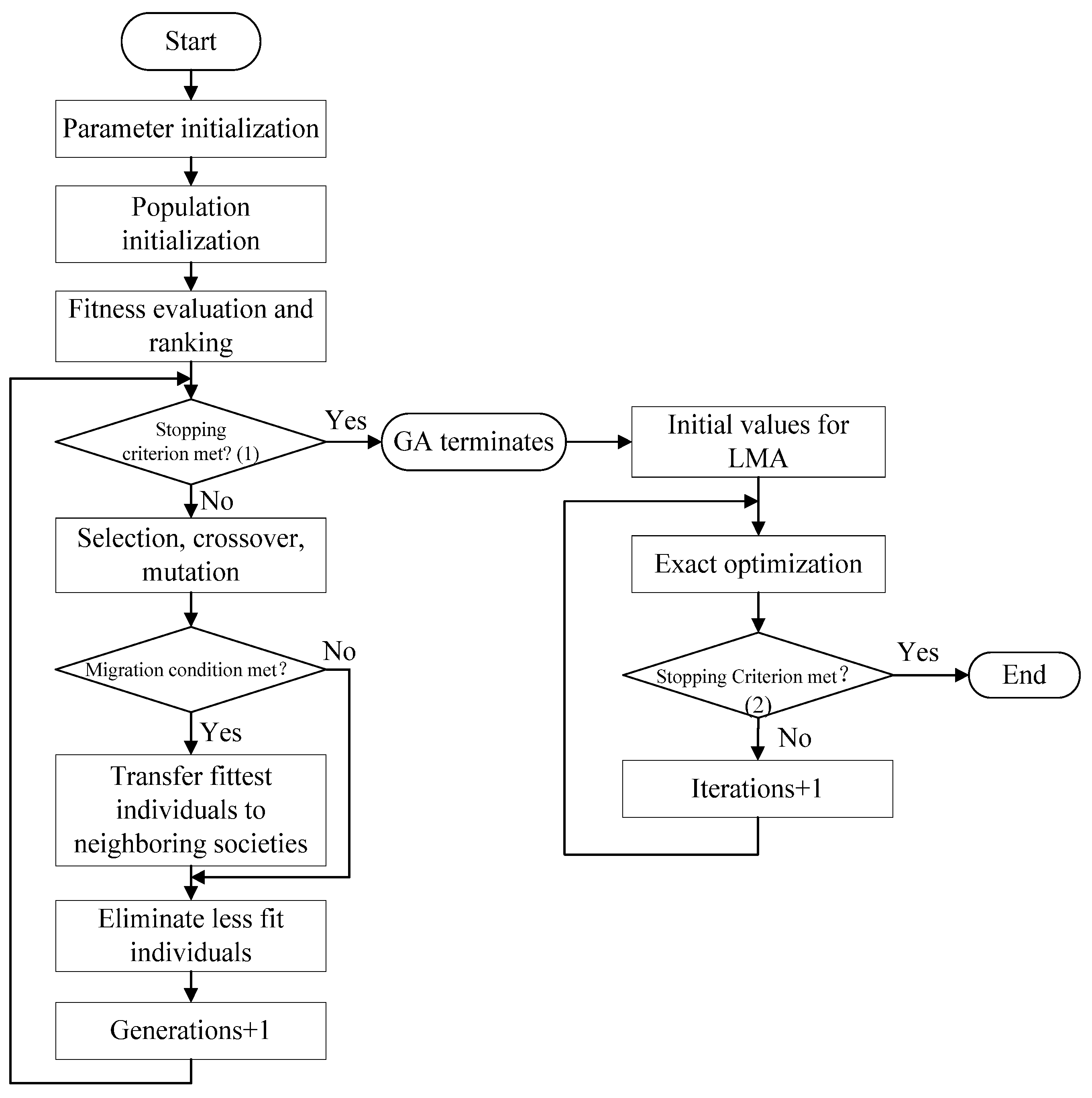

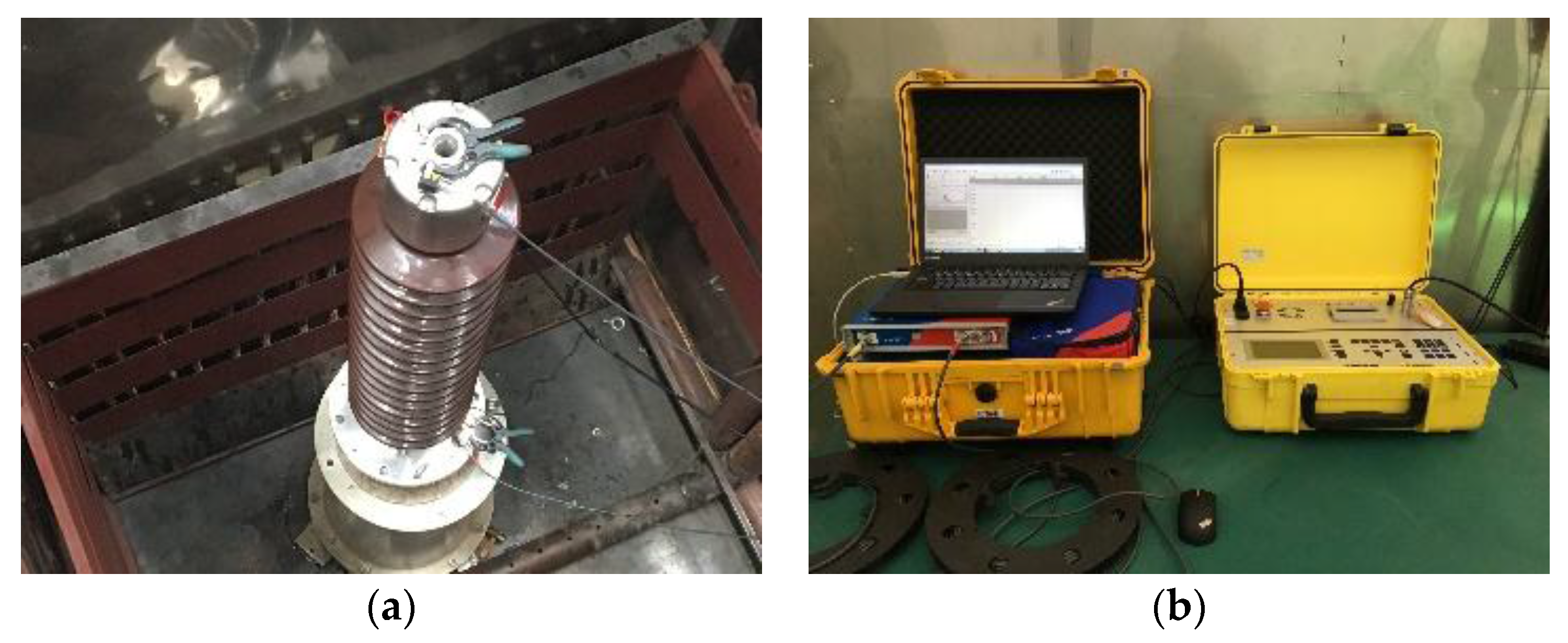

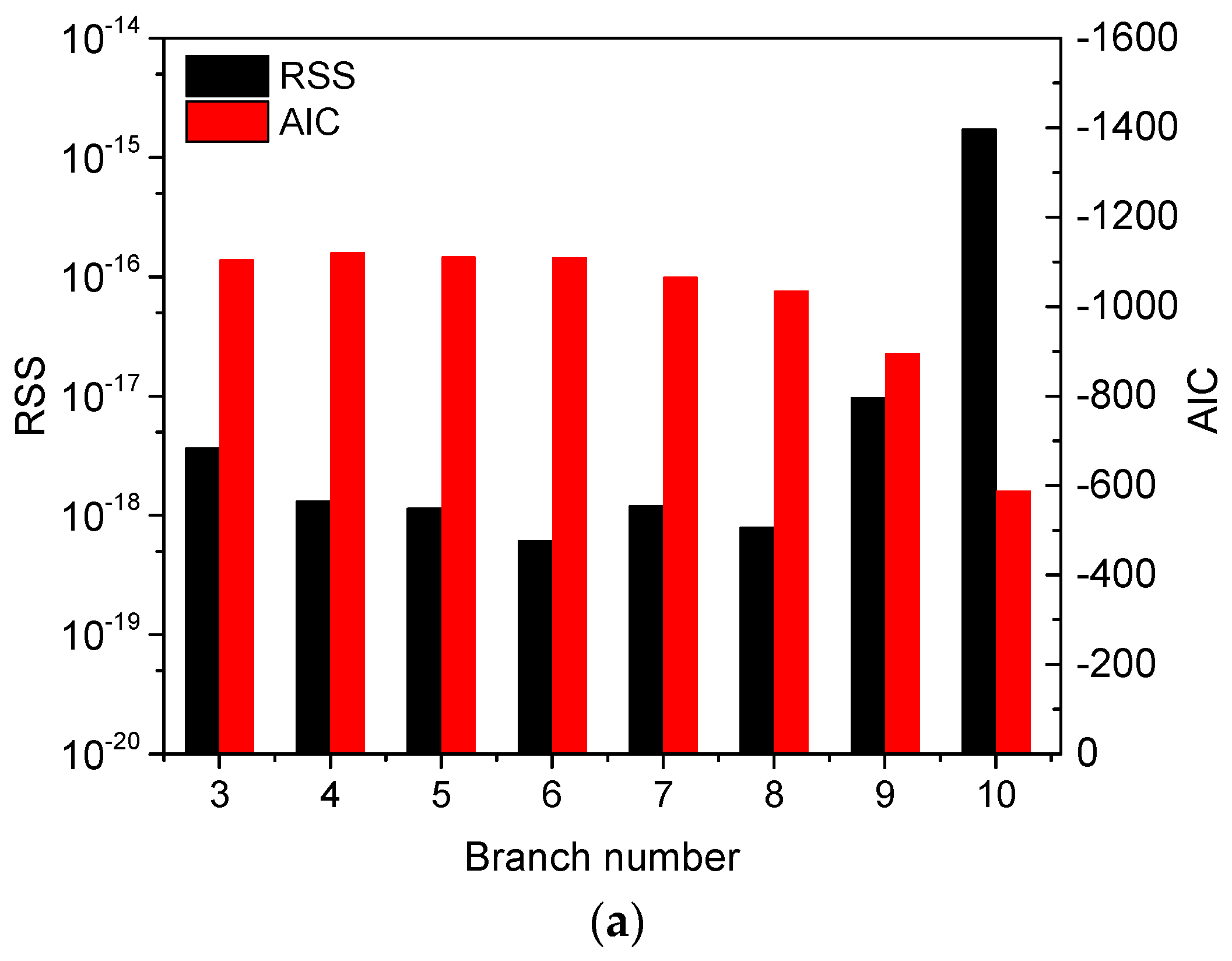

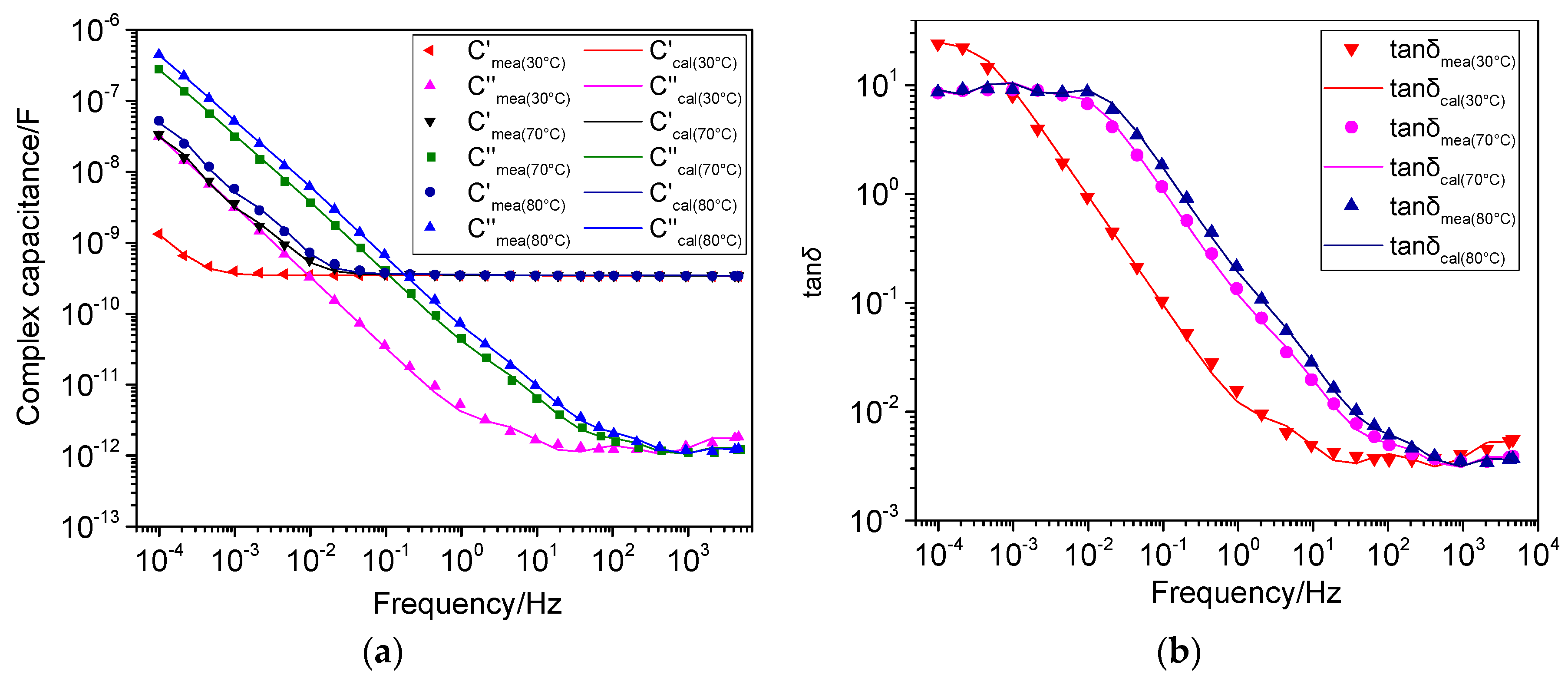

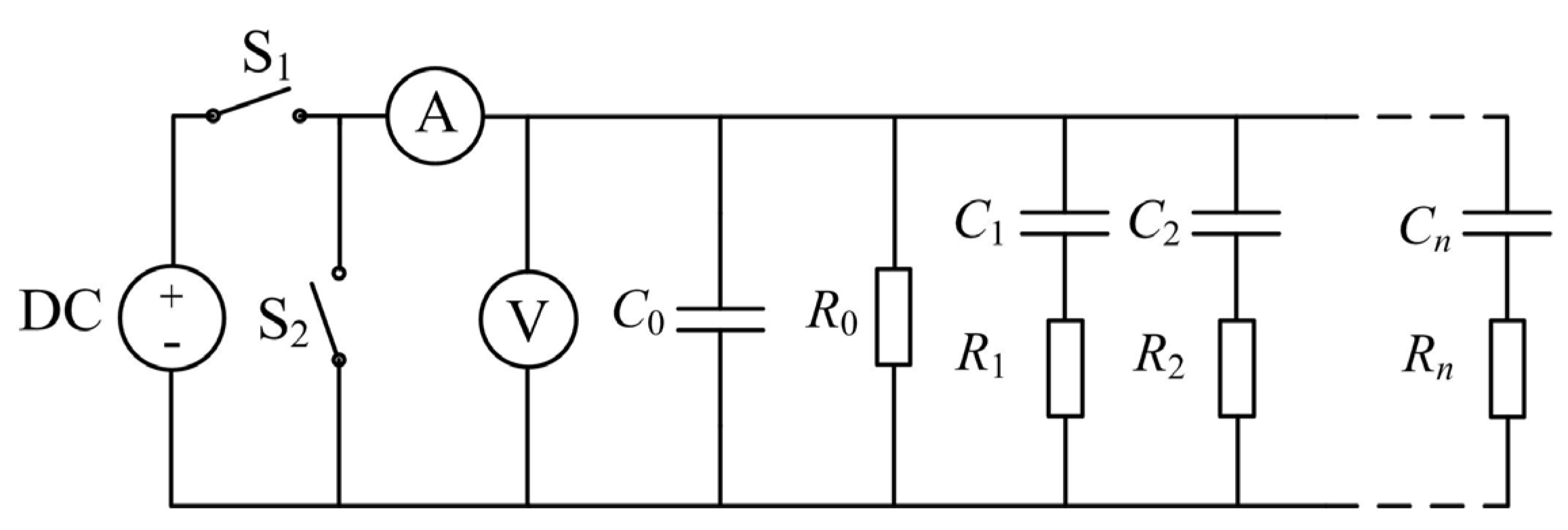
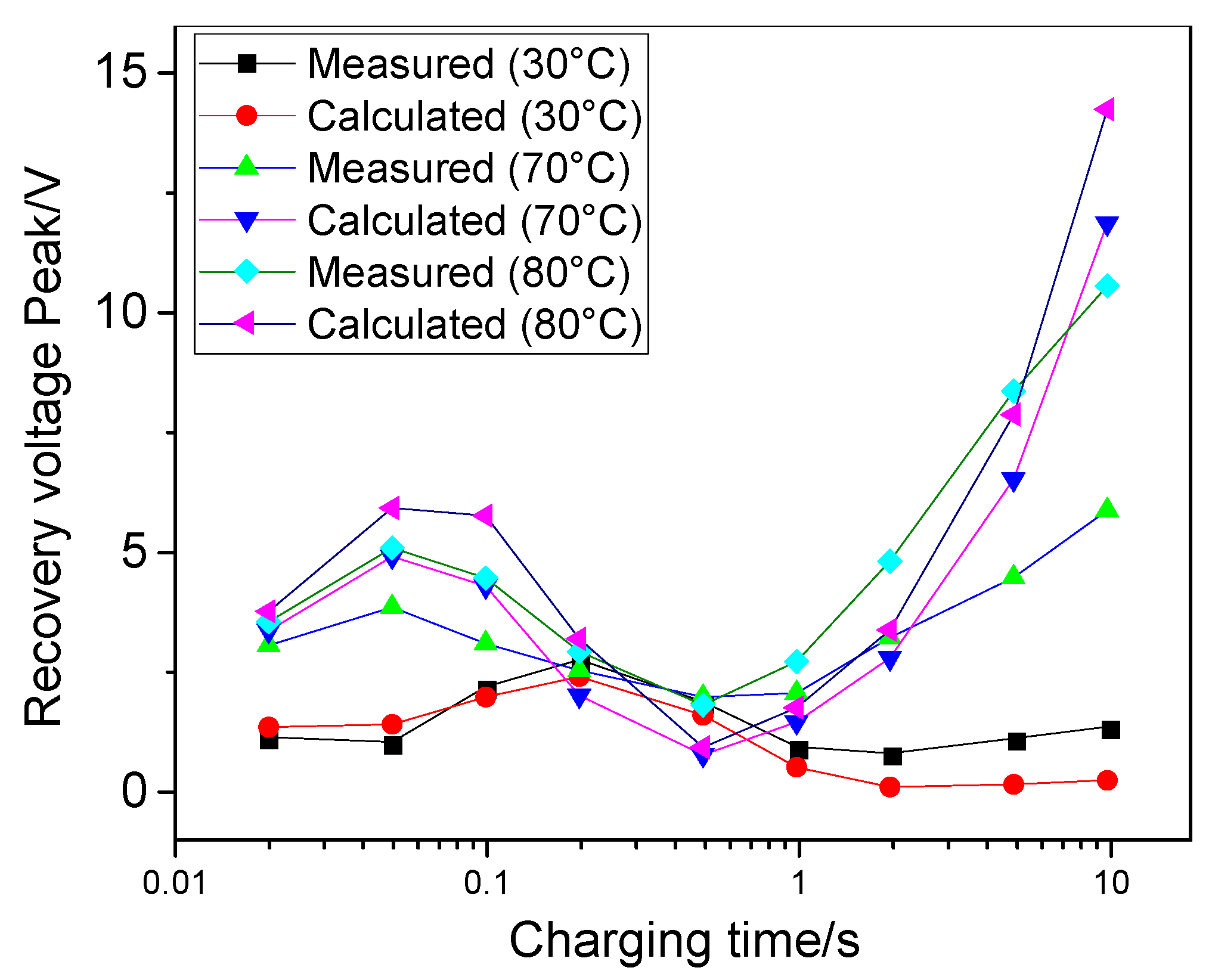
| Temperature (°C) | C′ | C″ | tan δ |
|---|---|---|---|
| 30 | 0.9938 | 0.9985 | 0.9970 |
| 70 | 0.9992 | 0.9990 | 0.9929 |
| 80 | 0.9974 | 0.9996 | 0.9928 |
| Branch No. | Ri (GΩ) | Ci (nF) | τi (s) |
|---|---|---|---|
| 0 | 52.16955 | 0.32593 | 17.00362 |
| 1 | 850.57341 | 1.86212 | 1583.86976 |
| 2 | 12.60626 | 0.00324 | 0.04084 |
| 3 | 0.63505 | 0.00211 | 0.00134 |
| 4 | 0.01399 | 0.00334 | 4.67266 × 10−5 |
| Branch No. | Ri (GΩ) | Ci (nF) | τi (s) |
|---|---|---|---|
| 0 | 6.1842 | 0.32893 | 2.03417 |
| 1 | 23.89544 | 38.74998 | 925.94782 |
| 2 | 28.02376 | 1.82357 | 51.10329 |
| 3 | 5.36016 | 0.00994 | 0.05328 |
| 4 | 0.48943 | 0.00206 | 0.00101 |
| 5 | 0.01946 | 0.00232 | 4.51472 × 10−5 |
| Branch No. | Ri (GΩ) | Ci (nF) | τi (s) |
|---|---|---|---|
| 0 | 3.84327 | 0.33044 | 1.26997 |
| 1 | 15.23857 | 60.5265 | 922.33731 |
| 2 | 14.98666 | 3.24172 | 48.58256 |
| 3 | 4.63316 | 0.01374 | 0.06366 |
| 4 | 0.47013 | 0.00222 | 0.00104 |
| 5 | 0.02076 | 0.00219 | 4.54644 × 10−5 |
© 2018 by the authors. Licensee MDPI, Basel, Switzerland. This article is an open access article distributed under the terms and conditions of the Creative Commons Attribution (CC BY) license (http://creativecommons.org/licenses/by/4.0/).
Share and Cite
Yang, F.; Du, L.; Yang, L.; Wei, C.; Wang, Y.; Ran, L.; He, P. A Parameterization Approach for the Dielectric Response Model of Oil Paper Insulation Using FDS Measurements. Energies 2018, 11, 622. https://doi.org/10.3390/en11030622
Yang F, Du L, Yang L, Wei C, Wang Y, Ran L, He P. A Parameterization Approach for the Dielectric Response Model of Oil Paper Insulation Using FDS Measurements. Energies. 2018; 11(3):622. https://doi.org/10.3390/en11030622
Chicago/Turabian StyleYang, Feng, Lin Du, Lijun Yang, Chao Wei, Youyuan Wang, Liman Ran, and Peng He. 2018. "A Parameterization Approach for the Dielectric Response Model of Oil Paper Insulation Using FDS Measurements" Energies 11, no. 3: 622. https://doi.org/10.3390/en11030622





